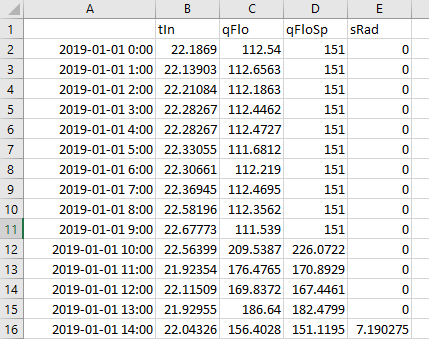Zone Anomaly
The zone anomaly function detects anomalous thermal zones based on indoor air temperature and airflow control error.
Inputs
Zone-level HVAC Control Network Trends
The zone anomaly function requires only zone-level HVAC control network trend data. These data are a record of various actuator and sensor measurements pertaining to variable air volume (VAV) terminal units which regulate airflow and sometimes re-condition supply air from the AHUs to specific thermal zone(s). For this analysis, four unique trend data are required for each thermal zone/VAV terminal unit; they are as listed with units and range in Table 1 and should formatted as seen in Figure 1.
| Required trend data | Abbreviation | Unit | Range |
|---|---|---|---|
| Indoor air temperature | tIn | oC | - |
| Supply airflow | qFlo | m3/s | - |
| Supply airflow setpoint | qFloSp | m3/s | - |
| State of perimeter heating device(s) | sRad | % | 0(inactive) - 100(fully active) |

The first column must contain the timestamp, which must include the numerical date and time and in the following format: [yyyy-mm-dd hh-mm]. Each subsequent column must contain the trend data as listed in Table 1 in descending order (i.e., second column contains indoor air temperature, third column contains supply airflow, etc.)
This function employs a clustering algorithm and, as a result, a minimum of six (6) CSV files containing zone-level HVAC control network trend data must be supplied to this function, where each CSV file represents a unique VAV terminal unit or thermal zone. Note that timestamps must be consistent between multiple files.
NOTE: For both seasons, if the supply airflow setpoint for a particular zone is equal to zero (0) for more than half the duration of the analysis period for the season (December through February for heating, May through August for cooling), this zone's data will be discarded and will not be reflected in the final results.